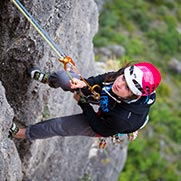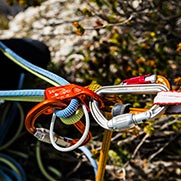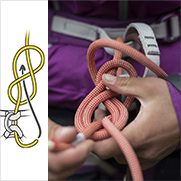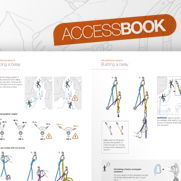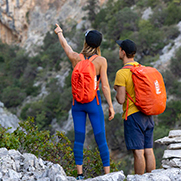Simultaneous progression and fall arrest in a crevasse with the RAD SYSTEM
Petzl conducted a series of crevasse fall tests to understand the forces at work and to confirm the suitability of RAD LINE use.
Warnings
- Carefully read the Instructions for Use used in this technical advice before consulting the advice itself. You must have already read and understood the information in the Instructions for Use to be able to understand this supplementary information.
- Mastering these techniques requires specific training. Work with a professional to confirm your ability to perform these techniques safely and independently before attempting them unsupervised.
- We provide examples of techniques related to your activity. There may be others that we do not describe here.
1. Using the RAD LINE cord for simultaneous progression on a glacier
Travel in a crevassed area is done with a taut rope; in case of a fall the belayer directly holds their partner.
To reduce the impact force on the belayer, it is generally recommended to use a dynamic rope, for example the PASO rope.
But in certain cases, the rope and bulk of the rope are significant factors. Petzl has thus sought a thin, lightweight rope suitable for simultaneous progression and for crevasse fall arrest.
After more than 110 crevasse fall tests under realistic conditions, the results are as follows:
• Whatever the rope used, arresting a crevasse fall is a risky and difficult maneuver.
• Success depends greatly on the conditions encountered (snow, slope...) and on the belayer's reaction when surprised (experience, weight ratio between partners...).
• With a dynamic rope, certain falls were not arrested.
• With the RAD LINE hyperstatic cord, certain falls were not arrested.
The RAD LINE can be used to arrest a crevasse fall during simultaneous progression on a glacier.
The impact force is not too high in this case.
The lack of elasticity can even be favorable in cases where the belayer is surprised by the fall.
2. To learn more: test protocol and detailed observations
Test protocol:
To better understand the forces at work in a crevasse fall, more than 110 fall tests were done under realistic conditions:
- Fall arrested by the belayer without the aid of an anchor (1).
- Belayer backed-up without interference with their mobility (2).
- Sensor on the belayer to measure and record the forces during the fall (3).
- Rope friction on the lip of the crevasse (4).
- Tension variations in the rope before the fall: sometimes quite taut, sometimes with a long loop of slack.
- Belayers and "victims" of different weights and technical skill levels.
- Varied test sites with differences in hardness and shape of the crevasse lip.
The first criterion recorded in the test is whether the fall was successfully arrested: if the belayer was held by the backup system, the fall was not arrested.
Next, attention was turned to a comparison between the RAD LINE hyperstatic cord and the PASO dynamic rope.
Typical curve profiles obtained in arresting a crevasse fall:
The sensor is positioned on the belayer, to measure the force transmitted to the belayer by the rope. This information is used to draw a curve representing the force at any moment during the fall.
Here are the typical curve profiles obtained with the PASO rope and the RAD LINE cord in the most common situations, with a successful fall arrest.
- Observation n° 1: the force rise
The force rise corresponds to the first slope visible on the curve recorded by the sensor. The steeper the slope, the more sudden the impact. A lower-angle slope indicates impact absorption by the rope.
The human body feels the difference in absorption between a static or dynamic rope, even if the maximum impact force is the same.
PASO: gradual force rise.
RAD LINE: brief or sudden force rise that can destabilize the belayer.
- Observation n° 2: the force of the first impact
The high point of the curve indicates the maximum impact force measured.
In the case of a crevasse fall with the belayer in motion, it is logical to see that the impact force recorded is slightly higher on a hyperstatic cord than on a dynamic rope.
However none of the values in our testing exceeded 2 kN; this value is quite low in the context of fall arrest.
- Observation n° 3: belayer performance
Two belayer reactions were observed regardless of the rope used:
Belayer able to resist being set in motion (possible with a favorable weight ratio and good reflexes).
Belayer set in motion by the first impact; able to hold after a few steps (the most common case).
- Observation n° 4: tension during fall arrest
Fall arrest comprises the entire braking and energy absorption phase after the first impact, until movement completely stops.
The curves are poor indicators of the sensations felt by the testers; the repeated testing is what enabled us to characterize the differences between the two ropes:
RAD LINE: regular feeling of tension, which facilitates belayer action.
PASO: irregular feeling of tension, which destabilizes the belayer. The rope alternates suddenly and unpredictably between low and high tension.
Summary:
The RAD LINE can be used to arrest a crevasse fall during simultaneous progression on a glacier.
The impact force is not too high in this case. The lack of elasticity can even be favorable in cases where the belayer is surprised by the fall.
The RAD LINE can be used to arrest a crevasse fall during simultaneous progression on a glacier.
The impact force is not too high in this case. The lack of elasticity can even be favorable in cases where the belayer is surprised by the fall.


